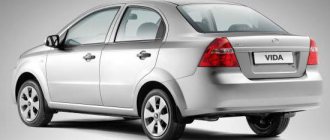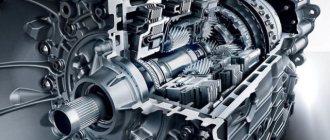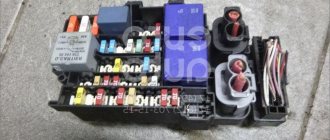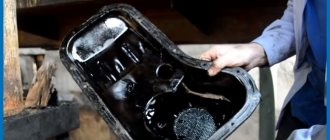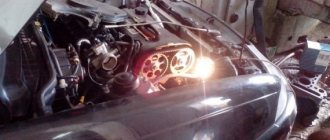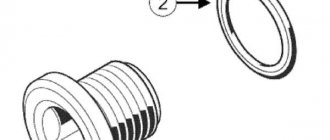Long gone are the days when automatic transmissions were treated with distrust, preferring “more reliable and specific” mechanics. Concerns regarding automatic transmissions did not arise out of nowhere. Most experienced car owners still believe that they consume more fuel, are more fragile than mechanical ones, are expensive to repair, reduce the dynamics of the car, etc. However, modern manufacturers refute such claims through the constant introduction of the latest technologies in the production of automatic transmissions.
CVT device and types of CVT
The CVT automatic transmission differs from its analogues in that it changes the gear ratio smoothly; in its design, for all gears (except reverse) there are no gear elements, that is, steps.
As for the types of variators, we can distinguish:
- toroidal;
- V-belt;
The toroidal variator is installed only on cars with all-wheel drive and rear-wheel drive. A toroidal CVT gearbox has two discs, one leading and the other driven. Special rollers are installed between the discs.
During operation, the rollers rotate relative to the horizontal axis and produce displacement relative to the vertical axis. This makes it possible to redistribute the force by touching different areas of the discs.
Simply put, depending on the degree of vertical movement of the rollers, it becomes possible to change the gear ratio, numbers, and due to the friction force of the rollers, torque is transmitted between the disks.
In the case when the rollers are in contact with the drive disk near the rim, the speed increases and the torque is less. This mode is similar to a high gear (5-6 on a manual transmission). If the rollers are in contact with the driven disk at the edge of the rim, the speed is lower and more torque is transmitted, which corresponds to a lower gear.
At the same time, the toroidal CVT variator is more reliable than the V-belt one, but if it breaks, it cannot be repaired. In other words, instead of repairing such a gearbox, it usually needs to be replaced.
- The V-belt variator is more common and is installed on cars with front-wheel drive. It is based on conical discs and a belt. The discs come in pairs (there are two such pairs in the variator), each pair has a stationary and a movable disc. In fact, they are pulleys that are connected to a corresponding shaft.
The principle of operation is that the input shaft delivers torque from the internal combustion engine to the drive pulley through a torque converter. In a gas turbine engine, the drive pump wheel transmits torque through oil to the turbine wheel connected to the input shaft.
Then, through the belt, the force from the drive pulley is transmitted to the driven pulley, which is also connected to the secondary shaft. The transmission of torque to the secondary shaft in order for the machine to move forward is carried out using a planetary gearbox with a disc clutch. To move backwards, a disc brake is used (reverse gear mechanism).
From the intermediate shaft, torque is transmitted to the differential, which distributes the force on the axle shaft. The torque and speed of the vehicle changes due to changes in the diameters of the variator pulleys. While the car accelerates from a stop, the diameter of the drive pulley is the smallest (similar to the 1st gear gear of a manual transmission), the discs are compressed.
Next, the diameter changes due to the movement of the pulley disks. When the discs are fully expanded, the pulley receives its largest diameter. It turns out that at a low vehicle speed, the diameter of the driving pulley is minimal, and the driven pulley, on the contrary, is maximum.
If the car is moving at high speed, the drive pulley has the largest diameter and the driven pulley the smallest. Adjustment of the driving speed is made possible by coordinated changes in the diameters of the pulleys. At the same time, due to the large number of possible diameters, the conditional number of available “speeds”, by analogy with a manual transmission or automatic transmission, is very large for a CVT.
Thanks to these features, good acceleration dynamics and smooth running are achieved; there is no interruption in the power flow, which occurs when changing gears in stepped gearboxes. Since there are no physical steps, there are no pushes, jerks, or failures. The CVT also saves fuel.
However, there are also disadvantages. As a rule, severe operating conditions and loads can quickly damage a CVT. Its service life is shorter than that of automatic machines or robots. In practice, when driving at full power and high speeds, the variator parts are destroyed, and this gearbox is usually not installed in tandem with powerful and high-torque internal combustion engines.
Even in a box, a variator needs to change the oil more often compared to hydromechanical automatic transmissions; only original fluid can be filled in; the oil itself for a variator is expensive. Repairing a variator is also a labor-intensive and complex process; replacing parts requires significant costs. Often, instead of repair, the practice is to completely replace the variator with a new or contract analogue.
Xtronic - operating principle and advantages
Xtronic is a state-of-the-art variable speed transmission (CVT), which is a rather complex mechanism. It is gradually replacing automatic transmissions and is characterized by such qualities as reliability, durability, and economical use.
In fact, it’s a stretch to call a CVT gearbox, since there is no gear as such, but a continuously variable transmission.
Changing the gear ratio in Xtronic is carried out as smoothly as possible, and therefore it is difficult to understand which gear is currently in use. This ensures the absence of jerks and jumps, regardless of the acceleration dynamics of the car.
Box CVT-XTRONIC
Having understood the main types of CVTs and their features, you can go directly to the CVT XTRONIC box. So, this type of gearbox can be found on models of the Renault – Nissan alliance (for example, the Kaptur CVT X tronic crossover or Nissan X-trail with this type of variator).
Let us immediately note that the development of XTRONIC belongs to the Japanese from Nissan. More precisely, we are talking about Jatco (a subsidiary of Nissan, which separately specializes in the production of automatic transmissions). Now let's answer what XTRONIC is. This CVT transmission is a modified version of the V-belt CVT, which, as the manufacturer assures, is free from many of the typical disadvantages of CVT.
The changes affected the design of the pulleys, as well as the transmission belt. The pulleys are made thinner, the transmission belt is based on aluminum, which somewhat reduced its flexibility. The compact and efficient oil pump increases reliability by reducing pressure between the pulleys and the belt.
We also recommend reading the article on how to tow a car with a CVT. From this article you will learn about the basic rules for towing a car with a CVT gearbox.
The box has become lighter and smaller in size, the noise level during operation has decreased, and friction losses inside the gearbox have been reduced by a full third. The unique Adaptive Shift Control system allows the box to flexibly adapt to almost any operating conditions.
The Xtronic gearbox also has an additional planetary gear, which is an innovation. This solution makes it possible to increase the gear ratio to 7.3/1 compared to conventional CVTs.
Also, the CVT Xtronic variator can work in tandem with powerful internal combustion engines without losing its service life. In a word, such a continuously variable transmission is a very promising development and can change the general idea of CVTs and their reliability.
In practice, owners note that this gearbox operates quietly even at low speeds, a car with such a CVT accelerates confidently, when driving the gearbox provides maximum comfort, and acceptable fuel efficiency is achieved.
Among the disadvantages, it is worth noting slipping in snow or mud, the same difficulties in repair, high cost of maintenance, and in many cases only component replacement in case of serious breakdowns. However, there are more positive reviews about the CVT Xtronic Nissan.
Correct operation of the variator
A CVT is an automatic transmission; you can find out the features and operating principle of a CVT in our instructions; if you need feedback, click here. If you are also interested in other gearboxes: DSG, automatic transmission (torque converter) or manual transmission, you can familiarize yourself with the nuances of proper operation using these links. I also want to clarify that the operation of CVTs of different brands, for example: Nissan or Toyota, is no different.
What not to do on a variator
- It is strictly not advisable to start from a traffic light with the pedal to the floor.
- Long driving at maximum speeds (rpm starts to float)
- If you get stuck, just ask someone to push the car.
- Driving at full load with a trailer
- Slippage in any form reduces the resource
Is it possible to turn on neutral on the variator when coasting?
CVTs, like standard automatic transmissions, are configured to drive in position D. You get behind the wheel, move the selector to Drive and go, no need to click into neutral.
How to control a CVT in a traffic jam
There is no need to engage the N position every time you stop. If you know that you will be standing for a long time, just move the selector to the P position.
Should I warm up the box or not?
The variator, like any unit with rubbing parts, requires warming up. The box needs to be warmed up. It is also recommended to drive at low engine speeds for the first few kilometers to optimally warm up the engine and transmission.
Emergency mode and CVT
If your automatic transmission emergency light comes on, the first thing you need to do is stop and try to start the car again. If the lamp does not go out, urgent diagnostics of the box is needed. There is no need to delay this.
Proper Maintenance
Monitoring the level and condition of the fluid in the variator is a mandatory procedure. According to the regulations, the fluid in the box must be replaced every 60 thousand km.
Monitor the cleanliness of the transmission cooling radiator; it is located behind the bumper. Blow or wash regularly. Overheating has never benefited anyone. I hope you learned something new from our guide. The main faults of the variator are available for viewing here
JF015E – 1.6 liters
This Renault Arcana CVT is combined with a 1.6 liter engine. Its production began back in 2010. It is aimed at engines whose volume does not exceed 1.8 liters.
The transmission itself is a symbiosis of a 2-speed hydromechanical automatic and a V-belt variator. 2nd gear is required for driving at speeds over 100 km/h. Its presence made it possible to exclude the least favorable mode of operation, when the belt is located near the edges of the cones.
In addition, the pulleys rotate in one direction, and not in different directions, as was the case on the previous model. The reverse gear is engaged outside the CVT part of the transmission.
Design features have led to the installation of this CVT X-Tronic on many models. The Renault Arcana 1.6 variator, like others, is able to simulate gear shifts and manual mode.
Changing the oil in this gearbox is a must. According to statements from representatives of service centers, oil changes should be made every 30,00 km. With such regulations, the transmission resource reaches 200,000 km.
Changing the oil, along with fine and coarse filters, is necessary, because the Renault Arcana variator, like any other, works on the principle of friction, which causes metal dust to form inside, which accelerates wear.
Exploitation
It is worth remembering that, subject to dynamic driving, the CVT X-Tronic wears out quickly. Sharp transitions from forward to reverse gears have a very negative effect on it. This also includes driving without warming up - it is recommended to turn on mode D in cold weather, press the brake pedal and wait about a minute.
This transmission had problems at first. The original software caused excessive wear and tear. In addition, the vane pump, bearings and valve body could also cause trouble. But all these shortcomings have been eliminated.
Possible problems
Despite the modernization, the Renault Arcana 1.6 CVT can present unpleasant surprises.
Bearings
As a rule, they are the first to fail to withstand the load. First, the bearing on the input shaft goes to waste, and then the rest. This is signaled by a hum from the box. And if you contact service in time, only one bearing will have to be changed. If you don’t pay attention, everything will end with the shafts being misaligned and the purchase of a new transmission.
Read more: Grinding noise when starting a car engine
Switching
Due to the gradual accumulation of metal dust in the Renault Arcana variator, which is formed during its operation, the valve body solenoids break, and the oil pump pressure reducing valve also suffers, which leads to a drop in oil pressure in the CVT X-Tronic, and the wear of the box begins to go much faster .
Sun gear
It is this planetary gear component that is at risk. It consists of 2 welded components, but the welding does not withstand the load. In this case, the car stops moving forward.
The presentation of Jatco JF016E took place in 2012. This 8th generation transmission has some design features that lead to an increase in its efficiency by 10%:
- Power range increased by 17%;
- The torque converter locks up earlier;
- Reduced internal friction due to the use of low viscosity oil;
- Software developed directly for Russia;
- More powerful oil pump with smaller dimensions, etc.
There is no provision for changing the oil in the Renault Arcana 1.3 variator, since it is filled for its entire service life. However, the service strongly recommends changing it at least once every 60,000 km. If this is done on time, only fill in high-quality liquid and comply with the operating conditions described above, the service life of the box reaches 200,000 km.
Possible problems
The reason for this is the insufficiently reliable cone bearings. And the reduction in the size of the oil pump components has an effect.
Jerks and jerks
According to reviews of the Renault Arcana variator, such problems may occur when switching. This is all due to an increase in the activation range of the fluid coupling lock, which leads to rapid wear of the clutch. This results in contamination of the fluid in the gearbox.
conclusions
The difference between conventional CVTs and Xtronic transmissions lies in the design differences. Thanks to the modernization of the device, the service life of transmissions was increased. Reviews about the unreliability of units are often left by car owners who do not comply with the rules for using gearboxes. Before buying a car with a CVT, you need to think about your preferred driving style. If you are aggressive or sporty, then it is better to avoid purchasing a car with a CVT, since such driving will quickly “kill” the transmission.
Disadvantages and frequent complaints from owners
- Often, on the forums of owners of cars equipped with a CVT, you can read negative reviews about the operation when releasing the gas. Owners are annoyed that the car begins to nod when the speedometer needle drops to 20 km/h.
- thoughtfulness can be considered a relative disadvantage, so if you are considering buying a car and counting on dynamic driving, then it is better to give preference to a car with a different transmission (mechanics or with a DSG robot). But this is not a drawback, but rather a feature of the X-Tronic CVT transmission, because... it was originally created for smoothness and fuel economy.
- a CVT-type box is very sensitive to overheating, this point could also be attributed to the above, because This problem applies more to fans of high speeds. So when driving on the highway, you should not overdo it with the gas pedal and the position of the speedometer needle (or, as an option: many Tian owners, especially with powerful engines, install an additional radiator to cool the box).
- sound accompaniment, like in a trolleybus, is another feature that owners often complain about at first. As they operate, according to the same owners, they get used to the sound and do not pay any attention to it. (Note that the sound from the X-Tronic variator is not so unbearable that it makes you want to leave the vehicle; it’s just that during operation there is a slight hum that is perceptible to the ear).
Read more: Electronic lighter with USB
Feel
There is not much to say about the Renault Arcana 1.6 JF015E variator, because the dynamics of acceleration to hundreds in 15.2 seconds, according to the technical specifications, demonstrates that this is a combination for an undemanding driver. However, the box works fine and does not become dull.
As for the combination of the 1.3-liter engine and CVT X-Tronic, it is not bad, but not outstanding. Reactions to pressing the gas pedal are smoothed out, which is especially pronounced when driving in a convoy. However, acceleration from a standstill is quite acceptable, although when overtaking on the highway you need some extra space. On the other hand, the gearbox provides an enviable smooth ride, and the car does not slip off-road.
As you can see, the Renault Arcana variator - both JF015E and JF016E - is not bad and quite copes with the responsibilities assigned to it. And the lack of an alternative in the trim levels forces you to choose a crossover with it. However, if you follow the recommendations for maintenance and operation, then there should be no problems with the CVT X-Tronic Renault Arkana.,
X-Tronic CVT
OPTIONAL RESEARCH и ваѸаÑоÑа, S.к. SMALL SMALL RESULTS »ÑÑ данной ÑÑанÑмиÑÑией, пÑиÑем наиболее RESULTS, RESULTS, RESEARCH ¸ÑÑ Ð°Ð²Ñо на вÑоÑиÑном ÑÑнке. RESULTS RESULTS RESEARCH, CONDITIONS ¸Â ÑвоевÑÐµÐ¼ÐµÐ½Ð½Ð¾Ð¼Ñ Ð¾Ð±ÑлÑжР› 150 000 км. RESULTS ºÐ¾ÑоÑÑÑ Ð´ÐµÑалей, ÑÑоимоÑÑÑ ÐºÐ¾ÑоÑÑÑ Ð½ÐµÂ Ñак Ñж RESULTS, RESPONSIBILITIES а пеÑÐµÐ´Ð°Ñ ÑпоÑобна пÑойÑи еÑе ÑÑолÑко же.
RESULTS RESULTS, RESULTS, RESULTS µ µ µ µ µ µ µ µ registry - registry ºÐ¾Ñобке либо пÑодолР› Ñми.
RESULTS › ½Ð°Â вÑоÑой план. RESULTS Ñомобилей, Ñо можно вÑделиÑÑ Ð´Ð²Ð° оÑновн SYSTEM ¸Ñ â ÑобоÑизиÑованнÑе ÑÑанÑмиÑии Ð¸Â Ð²Ð°Ð¸Ð°Ñ Ð¾ÑÑ. RESULTS ROOM, ROOM но недавно Ð ¸Ñ SÑÑали ÑÑÑанавливаÑÑ Ð¸Â Ð½Ð°Â ÐºÐ¾ÑейѺие мод ели. RESULTS оизводиÑелей. RESULTS, RESULTS Audi ²Ð°ÑиаÑоÑом , RESULTS RESULTS .
